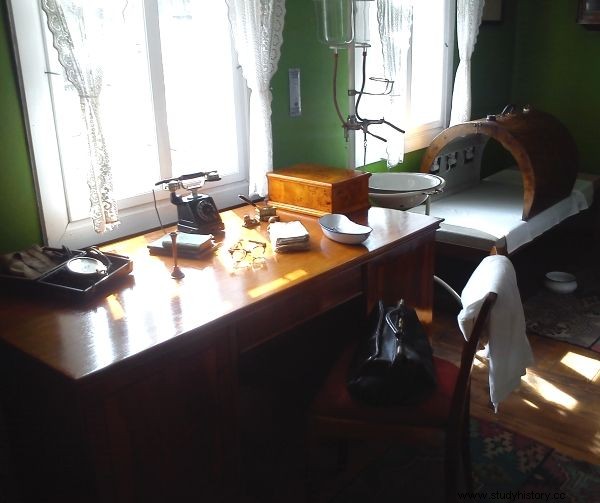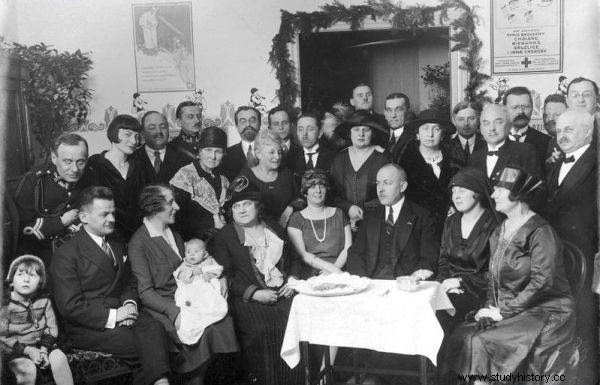In today's world, we are bombarded from everywhere with smiling babies from advertisements of diapers and baby jars. It is very easy to find dozens of forums for future parents on the Internet, and each kiosk has at least one press title devoted entirely to parenting. Knowledge is at your fingertips. And how was it in the times of the Second Polish Republic?
To begin with, there were no pregnancy tests available on almost every corner before the war. Most women, knowing their body, therefore stated their different state "by eye". It was known - nausea, menstrual arrest, abdominal rounding were a clear signal. However, when the ladies wanted to be sure, they directed their steps to specialist doctors. These, in turn, did not develop 100% certainty about the patient's pregnancy only when the baby's movements began to be felt. They preferred to postpone the moment of announcing the happy news to the woman rather than to confuse the fetus with a tumor (ultrasound machines did not come into use in hospitals until the late 1960s).
What will it be? Boy or girl?
When it was certain that a little man was growing in the womb of a woman, the pregnant woman changed her lifestyle a bit. Naturally, she did not start by completing pink or blue wraps and all the color embarrassment, after all, the child's sex remained a mystery until birth. One might guess with superstition, but in reality the first person to know if it was a boy or a girl was naturally the one delivering the delivery. What's more, at the beginning of pregnancy, it was not even known how many embryos the woman was carrying (today, future parents count the "beans" on the ultrasound monitor).
In any event, pregnancy was not considered a nine-month-long severe illness. Although the blessed woman had to give up some of the activities (e.g. horse riding, cycling, etc.), she did not spend the entire period in bed. The only really visible change was a different approach to the wardrobe. Today, future mothers rather emphasize their pregnancy belly, before the war it was the other way around. Loose dresses, scarves and coats perfectly fulfilled the masking role. It was simply not appropriate to dazzle with the fact of carrying a small citizen or citizen under the heart.

Pre-war doctor's office at the exhibition of the Kielce Countryside Museum. Women were frequent visitors to similar places - though usually only when they were forced to do so by advanced pregnancy or serious health problems.
Future mothers were also advised to wear a pregnancy belt. Today, such a contraption exists in two types. The first one is designed to support the tummy and relieve the spine in this way, and the second one is rather decorative (covers fragments of the naked body escaping from under the blouses tied at the front). Before the war, it was recommended to wear a belt for a completely different purpose. His job was to ... support the uterus. This was explained in detail by Dr. Janina Świtalska in her letters to her daughter who was expecting a child:
The first task of the maternity belt is to support the uterus. […] The belt should connected with elastic bands with stockings made of a special braid (knitted) - comfortable to wear and easy to wash.
You can see the head!
Suppose nine months of pregnancy passed without any complications. Time for a solution. In the interwar period, it was possible to decide on one of two possibilities:home birth or in a clinic / hospital. The first option was to use the services of a midwife. Moreover, the conditions in which the child was born might have left much to be desired. If the woman in labor was a poor housewife, paid work made it impossible for her to take care of the apartment or she simply patted poverty, under the midwife's feet there was a whole game of mice and rats, starting with cockroaches, and ending with bedbugs. Brr!
Richer ladies had 24/7 care at home, they had comfortable and hygienic conditions. Before the delivery, their room was properly arranged, removing all unnecessary equipment, changing the bedding, and preparing bowls, sheets, soap and other necessary things. As for clinics, their standard also depended on the wealth of the wallet. It was possible to go to a dying room, where puerperal fever was the norm, and to an elegant and professional medical facility. Although women's magazines and guides tried to reassure expectant mothers by giving them useful advice, the fear of childbirth remained.
Finally, a little creature appeared in the house. The baby was turned upside down by the life of a young mother. Of course, well-to-do ladies were in a much better situation than, for example, rural women who worked in the fields until their ninth month of pregnancy and returned to their duties right after giving birth. In middle-class and upper-class families, the baby was looked after by a specially employed babysitter, called a bona, and, if necessary, by other maids. More and more often - contrary to the old customs - also rich ladies took care of the child on their own.
Breast or bottle?
Pre-war journalists vigorously promoted breastfeeding as the most appropriate for a newborn. If we rely on information from magazines, it turns out that Polish women did not give up feeding their babies. However, when for some reason the mother did not have food or could not give it to the baby, there were several alternatives to choose from. She could feed the baby with cow's milk, hire a mummy or rely on the "Drop of Milk" organization, which provided ready-made food for babies.

Opening of the clinic of the "Drop of Milk" Society in Łódź. With the emergence of such establishments, new mothers had more and more opportunities.
The Society went much further in its activities and ran clinics where young mothers could consult midwives, nurses and paediatricians at any time. At the same time, the higher the vertebrae, the greater the reluctance to breastfeed. Unfortunately, many a distinguished lady was afraid that the baby would spoil her "advantages", which would later look bad in a low-cut dress at the prom.
Over the years, women received further facilities. In fact, an entire industry producing for the needs of children was born. Mothers had newer and newer care products, fresh guides in line with the latest state of research, and a whole host of items whose sole purpose was to make their lives easier.
The division of upbringing duties in the family was unequal. Most fell as usual on the mother. The hectic daily routine, professional work, looking after the servants, taking care of the house, representing my husband in salons, receiving guests and other similar tasks took a lot of time. Was the pre-war period longer than the present day?
Bibliography:
- Irena Krzywicka, Confessions of a Scandalous , Czytelnik, Warsaw 1996
- Katarzyna Sierakowska, Parents, children, grandparents ... Big-city intellectual family in Poland 1918-1939 , DIG Publishing House, Warsaw 2003
- Jadwiga Śięćowska, Hygiene of a woman in all periods of her life with special emphasis on maternity and infant hygiene , Lviv 1924
- Julja Świtalska, Cosmetics and child hygiene , Printing House of the Ministry of Military Affairs, Warsaw 1929
